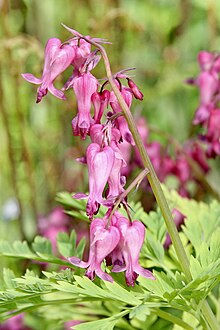Dicentra eximia
| Dicentra eximia | |
|---|---|

| |
| Scientific classification | |
| Kingdom: | Plantae |
| Clade: | Tracheophytes |
| Clade: | Angiosperms |
| Clade: | Eudicots |
| Order: | Ranunculales |
| Family: | Papaveraceae |
| Genus: | Dicentra |
| Species: | D. eximia |
| Binomial name | |
| Dicentra eximia (Ker Gawl.) Torr. | |
Dicentra eximia (wild or fringed bleeding-heart, turkey-corn) is a flowering plant with fernlike leaves and oddly shaped flowers native to the Appalachian Mountains. It is similar to the Pacific bleeding-heart (Dicentra formosa), which grows on the Pacific Coast. Dicentra eximia is a perennial herb in the Papaveraceae family.[2]
Description
Leaves are finely divided and gray-green, growing from the base of the plant.
Flowers are pink and bloom in tight clusters at the top of leafless, fleshy stems above the leaves from mid-spring to autumn. The four petals are connected at the base. The two outer petals are pouched at the base and bent back at the tips. The inner petals are perpendicular to the outer petals and connected at the tip. The pistil is enclosed within the inner petals, and the two stamens are on either side. There are two tiny, triangular, pink sepals above the petals.
Seeds are borne in a plump, pointed pod. They ripen to black while the pod is still green. Each has a white elaiosome prized by ants.
Pacific bleeding-heart (Dicentra formosa) is frequently confused with and sold as Dicentra eximia. It has wider, more rounded flowers with shorter wings on the outer petals (see the photo below).
- Flower and fruit structure
- A cluster of buds
- Almost opened flowers
- A cluster of opened flowers
- Flower shape: Dicentra 'Luxuriant' (a Dicentra formosa hybrid) compared with Dicentra eximia
- The flower's structure: four petals, two stamens, and a stigma
- Pod and ripe seeds with white elaiosomes
Ecology
Fringed bleeding-heart is native to the Appalachians from southwestern Pennsylvania south to Tennessee and North Carolina. It typically grows in rocky woodland at an altitude of 330 to 5,575 ft (100 to 1,700 m).[3] It is known as a pollinator plant that attracts hummingbirds and bees. [4]
- Wild plants
- A plant with flowerbuds
- Another wild plant in West Virginia
Cultivars
There are several cultivars of Dicentra eximia. Some are hybrids with Dicentra peregrina and Dicentra formosa.[3]
- Dicentra eximia
- Dicentra eximia 'Alba' — white flowers
- Dicentra eximia 'Snowdrift' — larger white flowers
- Hybrids
- Dicentra 'Bountiful' — Dicentra formosa subsp. oregana × Dicentra eximia — rosy red flowers
- Dicentra 'King of Hearts' — Dicentra peregrina × (Dicentra formosa subsp. oregana × Dicentra eximia) — pink flowers, very finely cut leaves
- Dicentra 'Luxuriant' — Dicentra eximia × Dicentra peregrina — cherry-red flowers
- Dicentra 'Silversmith — Dicentra formosa subsp. oregana × Dicentra eximia — white, pink-flushed flowers
- Dicentra 'Stuart Boothman' — probably Dicentra formosa subsp. oregana × Dicentra eximia — deep pink flowers
References
- ^ NatureServe (5 January 2024). "Dicentra eximia". NatureServe Network Biodiversity Location Data accessed through NatureServe Explorer. Arlington, Virginia: NatureServe. Retrieved 18 January 2024.
- ^ "Dicentra eximia - Plant Finder". www.missouribotanicalgarden.org. Retrieved 2021-11-03.
- ^ a b Tebbitt, Mark; Lidén, Magnus; Zetterlund, Henrik (2008). Bleeding hearts, Corydalis, and their relatives. Timber Press. pp. 61–63. ISBN 978-0881928822 – via Internet Archive.
- ^ Ley, Elizabeth. "Selecting Plants for Pollinators - Central Appalachian Broadleaf Forest" (PDF).
External links
- Flora of North America: Dicentra eximia — map
- Native Plant Identification Network
- PlantFinder — Kemper Center for Home Gardening, Missouri Botanical Garden










